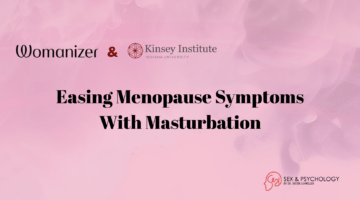Why Does The Female Orgasm Exist?
June 29, 2014 by Justin Lehmiller
Women have the potential to become pregnant whether or not they reach orgasm during vaginal intercourse. This observation has generated a long-standing scientific debate about why women have orgasms in the first place. If the female orgasm is not essential for reproduction, then what purpose does it serve? Although scientists do not yet agree on the answer, a number of interesting theories have been offered.
Some have argued that the female orgasm is a “sperm retention mechanism” that increases the odds of conception. The thought here is that uterine contractions during orgasm serve to draw sperm further into a woman’s reproductive tract. Scientists have found some evidence suggesting that this might indeed happen.
In one study, female participants were asked to collect “flowback” after unprotected vaginal intercourse [1]. In other words, they collected ejaculate that seeped out of the vagina after sex. Scientists then did a sperm count on each flowback sample and related this count to whether or not women reported having an orgasm. What they found was that when women reached orgasm around the same time as their male partners, the flowback contained less sperm than when women didn’t orgasm at all or reached orgasm much sooner than their partners.
However, this study has its flaws. For one thing, we don’t know how much sperm was actually released during each ejaculation to draw firm conclusions about how much of it was retained. Moreover, if we accept the argument that the female orgasm really does help to retain sperm, then why do so many women have difficulty reaching orgasm during vaginal sex, and why does it often take women much longer to have an orgasm than men?
An alternative theory is that perhaps there is no adaptive value to the female orgasm and, instead, the pleasure it provides is just a “fantastic bonus” for women [2]. The “fantastic bonus” theory argues that the female orgasm is just a byproduct of how the tissues in the human body are laid out in early development.
Regardless of whether someone is biologically male or female, everyone looks the same when they are initially in the womb. During the first two months of development, the genital structures are undifferentiated and have the potential to develop into either penises and scrotums or vulvas. The male and female genitals actually develop out of the same embryonic tissues and nerve structures—and these structures are laid out in order to ensure orgasm if a male develops because the male orgasm is necessary in order for men to sexually reproduce. Because men’s ability to reach orgasm is so heavily favored by our biology, it may be that the female orgasm is just a byproduct of this.
Another way to think about this is that the female orgasm has a lot in common with the male nipple in terms of why it exists. Biology favors nipple development in women in order to make breastfeeding possible. Men’s nipples don’t serve any known biological or reproductive function; however, they do contain many nerve endings, therefore making them a potential “bonus” in the bedroom (in fact, survey studies have found that most men report that nipple stimulation can lead them to become sexually aroused). So, perhaps female orgasms and male nipples are both nothing more than fantastic bonuses of nature.
Lastly, keep in mind that these are just a few of the many theories out there on the origin of the female orgasm and they certainly do not represent the last word on this topic. To learn more about the science behind orgasms, click here.
Want to learn more about Sex and Psychology? Click here for more from the blog or here to listen to the podcast. Follow Sex and Psychology on Facebook, Twitter (@JustinLehmiller), or Reddit to receive updates. You can also follow Dr. Lehmiller on YouTube and Instagram.
[1] Baker, R.R., & Bellis, M.A. (1993). Human sperm competition: Ejaculate manipulation by females and a function for the female orgasm. Animal Behavior, 46, 887-909.
[2] Lloyd, E. (2005). The case of female orgasm: Bias in the science of evolution. Cambridge, MA: Harvard University Press.
Image Source: iStockphoto
You Might Also Like:

Dr. Justin Lehmiller
Founder & Owner of Sex and PsychologyDr. Justin Lehmiller is a social psychologist and Research Fellow at The Kinsey Institute. He runs the Sex and Psychology blog and podcast and is author of the popular book Tell Me What You Want. Dr. Lehmiller is an award-winning educator, and a prolific researcher who has published more than 50 academic works.
Read full bio >


